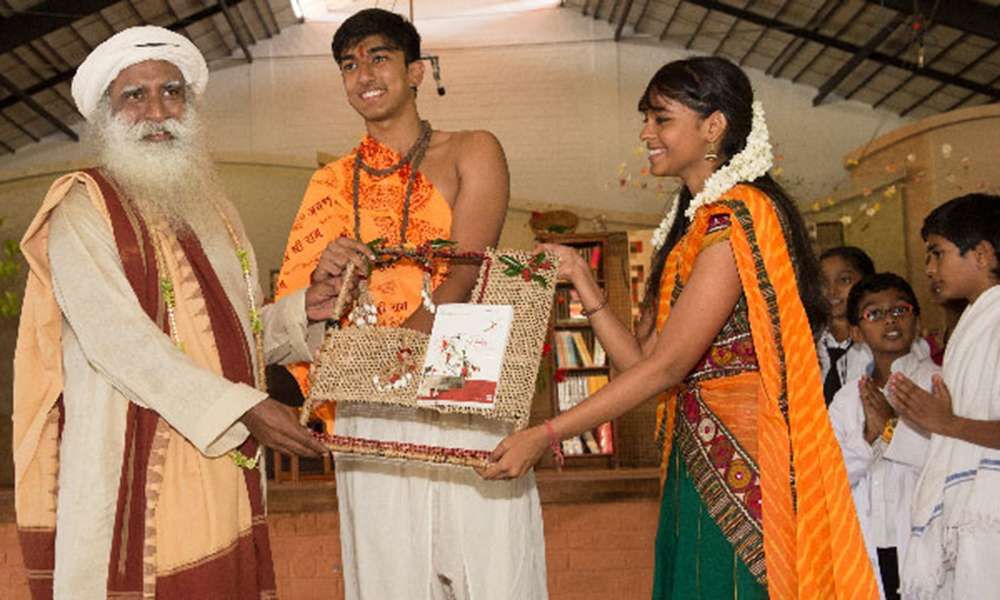“Homegrown Tales” – Isha Home School Book Release
Isha Home School students have released their very own book of short stories, titled “Homegrown Tales.”

Isha Home School students have released their very own book of short stories, titled “Homegrown Tales.”
On April 3rd, a bright, sunny day full of the excitement accompanying the end of another school semester, the students of Isha Home School (IHS), along with many of their parents, members of the press, and several special guests gathered at the school’s Tarana pavilion. The breezy and colorful venue often hosts student activities and assemblies, which include presentations and workshops from India’s top thinkers, leaders, and performers. On this day however, those gathered in Tarana were there to watch the launch of the school’s first “homegrown” book – a collection of short stories from 28 young authors, aged 8-18, all IHS students.
The process of the book’s creation took place in collaboration with Quill Club Writers, a publishing house which works with school children to become authors of published fiction, allowing them to experience every aspect of the writing and publishing process along the way. The 28 students whose work is featured in the collection were selected from over 150 initial applicants. They participated in a semester of intensive sessions, during which they pitched ideas to the group, brought unique characters to life, and painstakingly refined their craft.

Their efforts culminated in the release of Homegrown Tales at a special ceremony, which included a skit inspired by the distinctive voices found in each story. The young authors took the stage, each one embodying a character from his/her tale – magical dancers, spooky spirits, wounded soldiers and Bollywood starlets – while one unsuspecting young man wandered through their world, encountering its intriguing twists and turns and ultimately enticing the audience to read the stories and discover these worlds for themselves.
Subscribe
Bharthi Senthil Kumar, age 9, shared that her short story, entitled “Green Cheer”, was her very first. She was inspired to try her hand at writing by her love of reading and especially her favorite author, Roald Dahl. Her favorite part of the writing process was choosing an idea – “I had so many!” she exclaimed.
Several older participants in the workshop shared that they had previously spent time on creative writing, both through their classes and activities at the school or as an individual pursuit. Oviya Thirumavalavan, 17, Amulya Chintaluri, 18, and Shreya Iyer, 16, shared that, before this process began, they had mainly written on their own as a means of personal expression. “One difference,” they explained, “was that now we had a target audience and a direction.” As they worked through, scrapped, and refined their various ideas which evolved again and again along the way, it was time to learn that, “it’s okay if you’re rejected.” “It hurts,” Shreya noted, “to be told that your idea is cliche!” However, by the end of the writing process, they were able to look back at earlier ideas which now, “looked childish” compared to their polished product.
Homegrown Tales will soon be available for purchase at leading bookstores and on Flipkart.
Expression and Perception
Sadhguru was also present at the function and spoke of how expression should be complemented by perception.
Sadhguru: The power of the written word is so immense upon our lives that we cannot think how we would be without having read anything. This power of the human mind to find expression to many impressions that we gather is a phenomenal thing. I know many technologies have come in recent times which people claim are path-breaking, but I would say, when the first word was written, that was the biggest step that the human being took. It was not entirely positive, because in some way, human beings shifted from perception to expression. The power of perception receded and the power of expression grew in leaps and bounds.The distinction between perception and expression is: expression is of social context, perception is of existential context. Because of the written word, our psychological space has become far more important than the existential space. Creation and that which is the source of creation receded, and the written word dances in the psychological sphere of our minds in such a big way.
So, all the young writers, not to discourage you, but as one spends a certain amount of time in expression, at least an equal amount of time should be spent in conscious perception. Then our expressions would be of immense value, rather than just entertainment.
Anyway, it’s wonderful that these 28 children have come out with their own book at this age and stage in their life. Congratulations.
Reviews
“Working with these 28 young authors has taught us that our children not only think deep but also have the ability to produce structures, professionally-written stories that can compete in the open market. They understand that writers of fiction are committed to entertaining the reader, and they take their job really seriously.” – Ruchira Mittal and Hemant Kumar, Quill Club Writers
“Homegrown Tales should be on the shelves of every person who wants to be, needs to be, whisked away. I certainly was, and will be, each time I dip into it” – Indrajit Hazra, author “The Bioscope Man”
“These stories are profound, funny, sensitive, brave and wholly delightful. One applauds such an emphatic debut.” – Shobha Viswanath, Publishing director, Karadi Tales
“Ranging from simple and sensitive, to fast-paced and gripping, these stories have me awe-struck at the talent they contain.” – Reena I. Puri, Executive Director, Amar Chitra Katha


